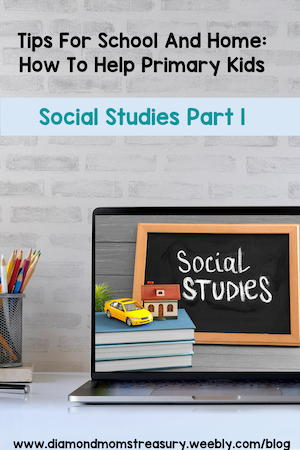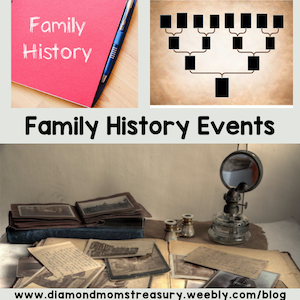Week 4 Focus: Primary Social Studies Part 1For the next couple of posts, I will be focusing on social studies, what it is, and how to help primary kids with tips for learning for school and home. What is social studies? In simple terms, it is the study of people and their relationships to other people and the world. For young children, it starts with family and then spreads out to community, regions, provinces, states, or territories, and from there, to countries and the world. It can be broken up into 5 different categories: geography, history, culture and society, civics and government, and economics. I will be focusing on some of these categories today, and some others next time. An important part of social studies is developing inquiry processes and skills for asking questions, gathering information, interpreting and analyzing it, and communicating effectively. It can involve mapping skills, learning about the world around them, and researching and reporting findings. For primary kids, the focus is on family, neighbourhoods, communities, and perhaps larger regions such as provinces, states, or territories. As they get to later primary grades, they begin to investigate their country, other countries, and the world. GeographyGeography is the study of places and the relationship between people and the environment. For simplicity we will be focusing on the study of places right now. This starts with looking at the neighborhood, the community, the town or city, the region, province, state, or territory, the country, the continent and the world. Mapping skills, designing and creating a community, or doing research on a city, region, or country all help kids to better understand the world around them. Mapping skills start with being able to recognize that maps are used to represent real places, and symbols or pictures are used to represent real locations. This progresses to being able follow a map to a destination, use cardinal directions, interpret symbols and legends, create simple maps, and read more complex maps. There are many different types of mapping activities that can be done to practice these skills. I wrote about many of these here. Here are some resources that can help with these skills. Mapping Skills Using Grids Mapping Skills Using Grids (online version) Creating A Community A fun extension to mapping is geocaching. This is like a scavenger hunt with added technology. The goal is to locate hidden containers by using a gps device to follow coordinates to specific locations. It is something that can be done as a family and lets people explore areas around them that they might not visit otherwise. Geocaches have been hidden all over the world, so it can be done when traveling as well. HistoryHistory is the study of past events, stories, and people in different places. This includes the significance of various events, objects, people, and places in the past and how they may impact our lives today. Then And NowWith young children, it is important to start with events that they can relate to. One way, is to look at the community they live in and find out how it has changed over time. There are many different ways to learn about the past and how things have changed over time. One way is to visit the local museum. I often booked field trips to our local museum. There were also video or slide show presentations there that showed how the city had changed over time. The kids loved seeing what it used to look like where current landmarks now sit. I also borrowed the kits they made available to use in the classroom that included artifact replicas that the children could handle and even try to use. Another place to find out information is the library. There you may be able to look at old newspaper articles or books that may have been written. Interviewing grandparents, seniors, or elders and looking at old photo albums will also provide some understanding of how life has changed over the years.
Timelines and order of eventsCreating picture timelines of families are great ways for young children to see how their families fit together. These could start at any point: when their parents met, when they were born, when they moved to a certain place. Community events timelines are a good way to help understand what events are significant in a community. These could be annual events, historic events, or even one time events that mark important happenings in the community. As children get older and begin to study a bigger part of their world, timelines could be done for larger regions, such as provinces, states, or territories, or even countries or the world. These timelines can be less pictorial and more detailed with dates and specific events listed. Culture, heritage, and traditions in societyDiverse cultures make up our communities and countries. They provide a rich blend of customs, art, music, traditions, holidays, food, clothing, and dress. It is important to value the many different aspects of culture that make us who we are as well. These characteristics of various cultures need to be acknowledged and better accepted in our communities. Research activities can be done and families can be involved in them. Several years ago, I had a student that was afraid to let people know about part of her heritage. Apparently, in another school she had been teased and she was afraid of this happening again. It made me sad to see a child so young feeling this way. I decided to create a project that would help her, and any others who may feel the same, to celebrate who they are and how their heritage made them the unique people they are. By the end of the project, she was excited to share that she had a mixed heritage and she began to feel proud of it. Here is the project we did. Another fun activity we did was a flat family project. It was based on the story of Flat Stanley and it came about after learning of a teacher who started send Flat Stanley on trips. In our case, we sent our flat families to other parts of the country and across the world to visit family members. You can read more about it here. As you can see, there are many different aspects to social studies. These are just some of the ideas and activities that you can try. I hope they are helpful for you. Next time, I will focus on other aspects of social studies. Related Posts
0 Comments
Leave a Reply. |
About Me Charlene Sequeira
I am a wife, mother of 4, grandmother of 9, and a retired primary and music teacher. I love working with kids and continue to volunteer at school and teach ukulele. Categories
All
|

















 RSS Feed
RSS Feed